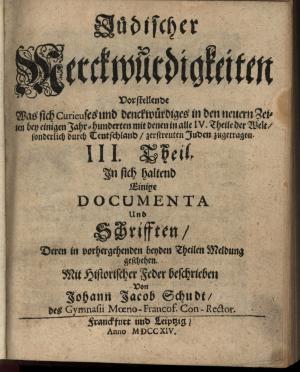Obj. ID: 40846
Jewish printed books Jüdische Merkwürdigkeiten by Johann Jacob Schudt, Frankfurt am Main, 1714

This text was prepared by William Gross:
"Jewish Oddities" by Johann Jacob Schudt – Frankfurt and Leipzig, 1714-1718 – An Engraving of a Judensau and Other Engravings – Jewish Texts Unknown from Other Sources Jüdische Merckwürdigkeiten [Jewish Oddities], by Johann Jacob Schudt. Four parts in two volumes. Frankfurt and Leipzig, 1714-1718. German, with some Hebrew, Yiddish and Latin. "Jewish Oddities" was published between 1714 and 1718, introducing one of the most comprehensive studies on Judaism until then: more than 3,000 pages documenting the minute details of Jewish life, dress, language, prayers, holidays and customs. Although the book did not address any particular community, most of the information it contains was gathered in the author's city, Frankfurt, and it provides a valuable documentation of the Frankfurt Jewish community. Several of the texts copied by Schudt (in Hebrew and Yiddish) are unknown from other sources: a Selicha authored by Rabbi Shmuel Schotten Katz following the great fire in the Jewish Quarter of Frankfurt in 1711; the Purim play "Ahasuerus-Spiel" (of which most copies were burnt following a rabbinical decree; the text was preserved only thanks to Schudt); two versions of women's incantations for childbirth; regulations of the Jewish community forbidding luxuries (see item 78); and more. Besides its documental value, the book is considered a landmark in the history of modern anti-Semitism, mainly due to a special chapter dedicated entirely to a description of the Jewish body – its shape, colors and smells (this chapter is considered a harbinger of racist anti-Semitism in Europe). The book features several engravings (some as separate plates and some in-text), including a portrait of the author, an engraving depicting Jacob blessing Joseph's sons, an engraving depicting two festive processions held in Jewish communities in Germany in 1716 for the birth of Leopold Johann, the son of the Holy Roman Emperor, Carl VI, and an especially offensive engraving of the Judensau ("Jews' Sow").
In four parts, this work is a valuable source of information on the Jews in Germany inspite of the author's prejudices. Schudt, a German Orientalist, was inspired to write this extensive chronicle following the great fire of the Frankfurt Ghetto in 1711. It is particularly comprehensive in relation to Franfurt Jewry in detailing local custom and way of life. The author also discusses the state of Jewry in other parts of the world.
Jüdische Merkwürdigkeiten by Johann Jakob Schudt. Frankfurt am Mann: Multze, 1718. [Jewish Curiosities: Imagining What Memorable Things Occurred in the New Times Over the Several Centuries, with the Jews scattered in all four parts of the world, especially by Germany; with a complete Franckfurter Jewish chronicle; with copper and figures]. Four volumes or parts with their own title page bound into one thick volume of over 1000 pages. Has two fold out plates and other illustrations, appears complete with engraved plates and illustrations In very good condition. It contains, amongst other information, details of contemporary Jewish life, a source for the history of the Jews, particularly those of Frankfurt.
Vol. I: [11] leaves, 159, 180-582 pp, [1] leaves; [4] leaves, 432, 383, [1] pp; [4] leaves, 358 pp, [31] leaves [3] large engraved plates and [2] small engraved plates, approx. 20.5 cm; Vol. II: [16] leaves, 320; 447, [1], 192 pp, [19] leaves, 48 pp, [1] leaf [2] large engraved plates and [2] small engraved plates,





















